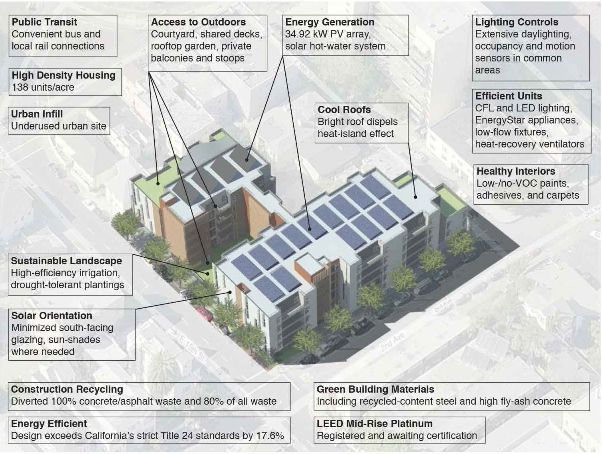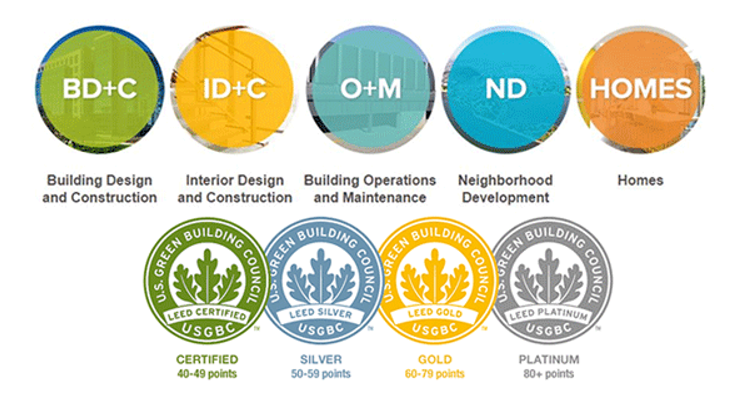
Share:
LEED (Leadership in Energy and Environmental Design) is a green building certification system developed by the U.S. Green Building Council (USGBC). It is one of the most prestigious certifications worldwide, evaluating projects based on energy, water, materials, indoor environmental quality, and impacts on communities and ecosystems.
What is LEED?
LEED (Leadership in Energy and Environmental Design) is a green building certification system developed by the U.S. Green Building Council (USGBC). It is one of the most prestigious certifications worldwide, evaluating projects based on energy, water, materials, indoor environmental quality, and impacts on communities and ecosystems.
For investors and developers, obtaining LEED certification not only enhances the value of the project but also demonstrates a strong commitment to sustainability while creating a competitive advantage in the market.
Vì sao LEED v4 quan trọng?

Why is LEED v4 important?
LEED v4 (launched in 2013, later updated to v4.1) marks a major step forward compared to previous versions with stricter and more comprehensive criteria. A project that achieves LEED v4 certification delivers tangible benefits to investors:
-
Reduced operating costs: Energy and water savings lower long-term expenses.
-
Increased property value: LEED-certified projects are valued higher in the market and attract tenants and partners more easily.
-
Incentives: Many countries and cities offer tax benefits, planning advantages, or financing support for LEED-certified projects.
-
Brand image: Reinforces corporate reputation through sustainability commitments.
-
Health and productivity: Green, clean, and comfortable spaces improve occupant well-being and performance.
LEED v4 Rating Systems

Projects can register under different categories, the most common being:
-
BD+C (Building Design and Construction): For new constructions.
-
ID+C (Interior Design and Construction): For commercial interiors.
-
O+M (Operations and Maintenance): For existing buildings.
-
ND (Neighborhood Development): For urban planning projects.
-
Homes: For residential housing.

Each project earns points across categories and is awarded a certification level:
-
Certified (40–49 points)
-
Silver (50–59 points)
-
Gold (60–79 points)
-
Platinum (80+ points)
Key Credit Categories in LEED v4
LEED v4 evaluates projects across eight major categories:

-
Sustainable Sites – Minimize environmental impact during construction.
-
Water Efficiency – Reduce water consumption and reuse water.
-
Energy & Atmosphere – Improve energy efficiency, integrate renewable energy.
-
Materials & Resources – Manage material life cycles, recycling, and reuse.
-
Indoor Environmental Quality – Ensure healthy air, lighting, and acoustics.
-
Innovation in Design – Encourage solutions that go beyond baseline standards.
-
Regional Priority – Extra points for addressing local environmental priorities.
-
Location & Transportation – Promote reduced travel needs and sustainable transport.
LEED v4.1 – A More Flexible Update

USGBC introduced LEED v4.1 to make certification more accessible, featuring:
-
More flexible criteria tailored to market realities.
-
Stronger requirements for operational performance and material transparency.
-
Digital tools to monitor and report project progress.
Conclusion: Why should investors care about LEED v4?
LEED v4 (and v4.1) provides clear proof of a commitment to sustainable development. Certified projects don’t just reduce costs and increase asset value—they also enhance corporate image, attract customers, partners, and top talent.
Investing in LEED v4 means investing in the future—one that is greener, more sustainable, and more competitive.
FAQ
1. What are the financial benefits of LEED v4-certified projects?
LEED v4 projects typically achieve 20–30% energy and water savings and are valued 5–10% higher than conventional buildings. In addition, many countries and cities provide tax incentives, planning advantages, or preferential loans for LEED-certified buildings.
2. How is LEED v4 different from previous versions?
LEED v4 sets stricter requirements in:
-
Energy efficiency (more detailed simulations).
-
Material transparency (requiring EPDs and HPDs).
-
Operational performance (evaluating not only design but also real-world use).
This ensures that green buildings are not just theoretical but genuinely high-performing.
3. Does LEED v4 improve occupant experience?
Yes. LEED v4 places strong emphasis on indoor air quality (IAQ), natural daylight, humidity, noise levels, and low-VOC materials. These factors directly enhance occupant health, comfort, and productivity.
4. How does LEED v4 compare with other green certifications like LOTUS or EDGE?
-
LEED v4: International standard, comprehensive scope (carbon, water, energy, materials, health, community). Globally recognized, boosting project competitiveness.
-
LOTUS: Vietnam’s local green building system, tailored to local climate and regulations, lower cost, suitable for domestic projects.
-
EDGE: Developed by IFC (World Bank), focuses on cost-effective energy and water efficiency, ideal for housing, hotels, and commercial projects in emerging markets.
5. How long does it take to achieve LEED v4 certification?
It depends on project scale and complexity:
-
Small projects or interiors (ID+C): ~6–12 months.
-
Large-scale new construction (BD+C): ~18–24 months (from registration to submission and approval).
Early planning during the design phase helps shorten the timeline and reduce risks of delay.
Latest news
Special Highlights of COP30: When the World Looks to the Amazon for Climate Action of the Future
COP30 marks the 30th Conference of the Parties to the UNFCCC (United Nations Framework Convention on Climate Change).
Criticality Assessment: The First Step Toward Building Resilience
Europe is entering a major transformation in resilience thinking. Under the Critical Entities Resilience (CER) Directive, organizations are not only required to manage risks but also to understand, demonstrate, and maintain the elements that are “critical” to their operations, economy, and society.
Carbon Trading Systems and the Reshaping of the Construction Industry’s Future
The construction industry is one of the largest sources of greenhouse gas emissions, accounting for around 37% of total global CO₂ emissions (IEA, 2022). The expansion of Emissions Trading Systems (ETS) beyond the energy sector into carbon-intensive industries — including building materials and operational processes — is reshaping the entire cost structure and competitive strategies of the construction sector.
Green Finance in Real Estate: Investment Opportunities and Strategies for Developers in Emerging Markets
The global real estate sector is both the largest source of emissions and the greatest investment opportunity in the journey toward net-zero. According to IFC (2025), greening the construction value chain could unlock USD 1.5 trillion in investment opportunities across emerging markets in the next decade.
LCA and EPD: Scientific Evidence for Transparency in Green Certifications
In today’s global context of increasing focus on sustainability, transparency in data has become a critical requirement in the construction industry. Two prominent tools that address this need are LCA (Life Cycle Assessment) and EPD (Environmental Product Declaration). Beyond helping projects earn credits in green building certification systems such as LEED or BREEAM, LCA and EPD are also long-term strategies to enhance credibility and value for projects.
ARDOR Green is recruiting the next generation of sustainable architects/engineers at the Bach Khoa Career Fair
Founded in 2005, ARDOR Architects has over 20 years of experience in architectural and urban planning consultancy, with participation in more than 150 projects and numerous international awards such as Top 10 Architects Ashui (2017) and BCI Asia Awards (2009, 2015, 2021).
Build Green, Build with ARDOR Green







